
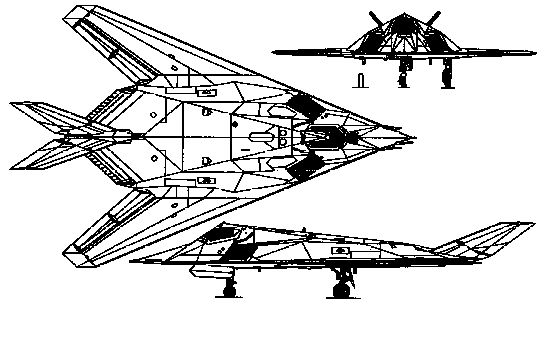

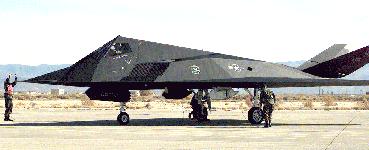
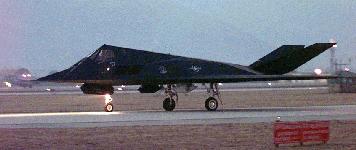




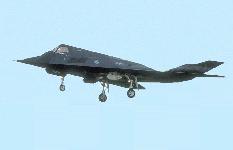
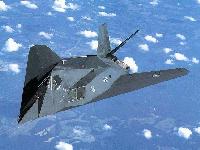


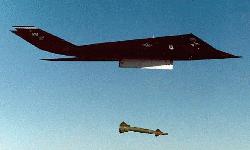

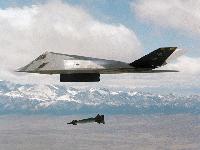

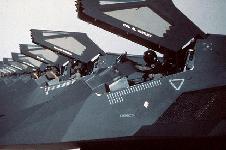
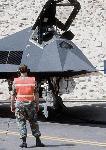
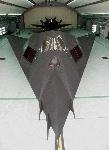

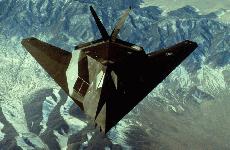


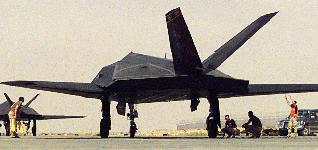
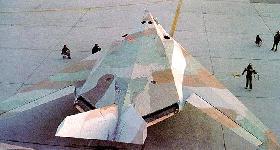
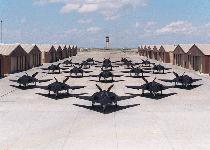

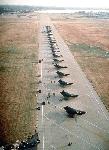


The F-117A can employ a variety of weapons and is equipped with sophisticated navigation and attack systems integrated into a state-of-the-art digital avionics suite that increases mission effectiveness and reduces pilot workload. Detailed planning for missions into highly defended target areas is accomplished by an automated mission planning system developed, specifically, to take advantage of the unique capabilities of the F-117A.
The first F-117A was delivered in 1982, and the last delivery was in
the summer of 1990. The F-117A production decision was made in 1978 with
a contract awarded to Lockheed Advanced Development Projects, the "Skunk
Works," in Burbank, Calif. The first flight was in 1981, only 31 months
after the full-scale development decision. Air Combat Command's only F-117A
unit, the 4450th Tactical Group, (now the 49th Fighter Wing, Holloman Air
Force Base, N.M.), achieved operational capability in October 1983.
The Nighthawk first saw action in 1989 during Operation Just Cause
in Panama.
The stealth fighter attacked the most heavily fortified targets during
Desert Storm, and it was the only coalition jet allowed to strike targets
inside Baghdad's city limits. The F-117A, which normally packs a payload
of two 2,000-pound GBU-27 laser-guided bombs, destroyed and crippled Iraqi
electrical power stations, military headquarters, communications sites,
air defense operation centers, airfields, ammo bunkers, and chemical, biological
and nuclear weapons plants.
Although only 36 stealth fighters were deployed in Desert Storm and
accounted for 2.5 percent of the total force of 1,900 fighters and bombers,
they flew more than a third of the bombing runs on the first day of the
war. In all during Desert Storm, the stealth fighter conducted more than
1,250 sorties, dropped more than 2,000 tons of bombs, and flew more than
6,900 hours. More than 3,000 antiaircraft guns and 60 surface-to-air missile
batteries protected the city, but despite this seemingly impenetrable shield,
the Nighthawks owned the skies over the city and, for that matter, the
country. The stealth fighter, which is coated with a secret, radar-absorbent
material, operated over Iraq and Kuwait with impunity, and was unscathed
by enemy guns.
Streamlined management by Aeronautical Systems Center, Wright-Patterson
AFB, Ohio, combined breakthrough stealth technology with concurrent development
and production to rapidly field the aircraft. The F-117A program has demonstrated
that a stealth aircraft can be designed for reliability and maintainability.
The aircraft maintenance statistics are comparable to other tactical fighters
of similar complexity. Logistically supported by Sacramento Air Logistics
Center, McClellan AFB, Calif., the F-117A is kept at the forefront of technology
through a planned weapon system improvement program located at USAF Plant
42 at Palmdale, Calif. The Air Force thinking today is that it will phase
out the Nighthawks after 2018.
Specifications |
|
| Primary Function | Fighter/attack |
| Contractor | Lockheed Aeronautical Systems Co. |
| Power Plant | Two General Electric F404 engines |
| Length | 65 feet, 11 inches (20.3 meters) |
| Height | 12 feet, 5 inches (3.8 meters) |
| Weight | 52,500 pounds (23,625 kilograms) |
| Wingspan | 43 feet, 4 inches (13.3 meters) |
| Speed | High subsonic |
| Range | Unlimited with air refueling |
| Armament | Internal weapons carriage
Two each of: 2 MK84 2000-pound
|
| Unit Cost $FY98
[Total Program] |
$122 million |
| Crew | One |
| Date Deployed | 1982 |
| Inventory | Active force, 54; ANG, 0; Reserve, 0 |
| PMAI
Primary Mission Aircraft Inventory Only combat-coded aircraft and not development/ test, attrition reserve, depot maintenance, or training aircraft. |
36 aircraft |





























